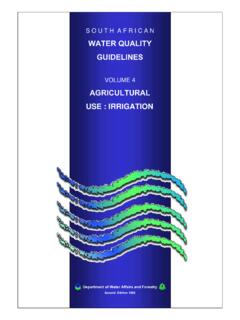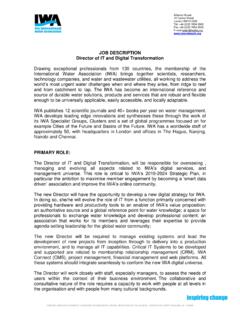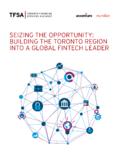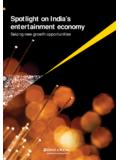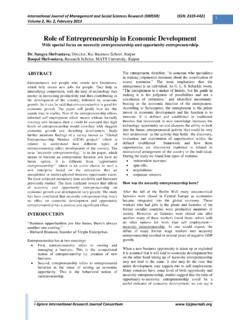Transcription of Wastewater Report 2017The Reuse Opportunity
1 State of the Art Compendium Report on Resource Recovery from WaterWastewater Report 2018 Wastewater Report 2017 The Reuse Opportunity List of acronymsBOD - Biological Oxygen DemandBOT - Build-Operate-Transfer GHG - Greenhouse GasMBR - Membrane Reactor MLD - Million Litre per DayMWh - Megawatt hourO&M - Operation and MaintenancePPP - Public Private PartnershipSDG - Sustainable Development GoalsSTP - Sewage Treatment PlantWWTP - Wastewater Treatment PlantsContents Cities seizing the Reuse Opportunity in a circular economy 02 Aqaba: A mid-size city turning its zero discharge challenge into a good Opportunity 03 Bangkok: Using sludge as a resource and a valuable economic good 05 Beijing: Building infrastructure to keep up with an ever expanding mega city 07 Chennai: Addressing water scarcity through accelerated Wastewater Reuse 09 Durban: Wastewater as an economic good 11 Kampala: Protecting its water source with an integrated plan to control, treat and Reuse Wastewater and septic sludge 13 Lima: Learning by doing under the urgency of shrinking glaciers 15 Manila: A mega city regenerating its resources through Wastewater treatment and Reuse 17 Summary 19 The IWA Principles for Water-Wise Cities 21 Acknowledgments City ContactAqaba Yasser Hanaqtah, Hotaf YassienBangkok Pathan Banjongproo, Tantikom SupachaiBeijing Mr.
2 Kuixiao LiChennai Shri Roy, Mr. RajamohanDurban Teddy Gounden Kampala Rose KaggwaLima Karina ValenzuelaManila Bernaliza EspinaInfographics data The population data was searched on the web from most recent sources available. The Wastewater sewer and treatment coverage, as well as the water Reuse , energy recovery and fertiliser value recovery was provided by local city contacts. City wide GHG emissions data was available only for the following cities: Chennai. Source: Powerpoint presentation by Sumana Bhattacharya, ICSD, India, Aug 2014, found on the web. Lima. Source: Carbon Disclosure Project website. Manila. Extrpolated from Source: Greenhouse Gas Emissions in the Philippines Factsheet, USAID Beijing. Source: CO2 emissions inventory of Chinese Cities, Atmos. Chem. Phys. Discuss., , 2016 Durban. Source: Summary Document: eThekwini Greenhouse Gas Emissions Inventory 2015, Energy Office eThekwini Municipality GHG emissions from Wastewater management was calculated using the ECAM tool, made available by the WaCCliM Report 201802 The theme for UN-Water World Water Day in 2017 was Wastewater which has helped to raise awareness of this global problem and create momentum amongst like-mind-ed organisations to drive change.
3 The change required is captured within target of the Sustainable Development Goals (SDG), which commits governments to halving the proportion of untreated Wastewater and substantially in-creasing recycling and safe Reuse by 2030. Today, around 80% of all Wastewater is discharged into the world s waterways where it creates health, environ-mental and climate-related hazards. Urbanisation further exacerbates this challenge with increasing Wastewater generation, while at the same time using more of Earth's dwindling resources. Recovering the water, energy, nutri-ents and other precious materials embedded in wastewa-ter is a key Opportunity to be seized. The discharge of untreated effluent in water bodies does not only lead to eutrophication and human health risks, it also contributes significantly to Greenhouse Gas (GHG) emissions in the form of nitrous oxide and methane. Emissions from untreated sewage represents three times the emissions of conventional Wastewater treatment.
4 The emissions from untreated sewage can represent a signif-icant percentage of cities' global emissions, even when treatment coverage is still poor as in many emerging SDGs demand we halve the amount of untreated Wastewater and provide universal access to adequate san-itation. During the same period, the global population is estimated to rise to billion people. These pressures will drive cities to address the Wastewater challenge and seize the Reuse Opportunity . Of paramount importance are the dual objectives of safeguarding human health and environ-mental protection, but beyond this, cities need to identify ways of deriving value from the materials, energy and water that is embedded in Wastewater , urgent and large-scale action is needed to increase Wastewater and fecal sludge treatment, Reuse and recycling. Cities should be empowered to take the lead on a resource revolution, with governments and the private sector investing heavily in infrastructure to enable a transition to a circular economy, bringing about significant environmental, economic and social benefits.
5 A portfolio of solutions includ-ing centralised and decentralised, natural and built, wet and dry concept of circular economy, which aims to decouple economic growth and development from the consumption of finite resources, has emerged in response to the draw-backs of the conventional take-make-consume and dispose model of growth. Water, with the energy it consumes and produces, and the materials it contains, has a critical role in transitioning to the circular water is one of the most under-exploited resources we have. Water from industrial or domestic use contains en-ergy, water, organics, phosphates, nitrogen, cellulose, rare earths, and other resources. Technologies are increasingly making resource recovery from Wastewater commercially feasible, including bio-gas, fertiliser, paper, metals, plastics and, perhaps most importantly, it is a source of new the water sector, transitioning to a circular economy presents an Opportunity to fast track achieving the SDGs through accelerating and scaling-up recent scientific and technological advances that support greater efficiency in the Report aims to illustrate the Wastewater challenge and Reuse Opportunity in eight cities across the globe, pre-senting a Reuse roadmap and identifying priorities and ben-efits to meeting SDG target The cities profiled in this Report are not the usual suspects of pioneering cities who have been on this trajectory for some time.
6 But rather cities small and large from developing countries where the existing and future challenges are felt more acutely and the need for change is seizing the Reuse Opportunity in a Circular EconomyWASTEWATER Report 201803 Aqaba: A mid-size city turning its zerodischarge challenge into a good Opportunity Aqaba, the largest city on the Gulf of Aqaba, lies at the crossroads of three continents as a major tourist destination and an attractive business centre. Benefitting from the special economic zone policies, Aqaba pioneered Wastewater Reuse in industries, boosted tourism and restored the world famous Aqaba Bird Observatory. The challenge to implement a zero sewage discharge policy is addressed by: (1) seizing the Opportunity to supplement the city s water resources with fit for purpose Reuse water that is then sold; (2) recovering energy from Wastewater to reduce the operating costs; and (3) drawing in private sector financing based on shared interests for an attractive and liveable city.
7 KEY DRIVERS WATER SCARCITY Jordan is one of the most water scarce countries in the world, with a national average water demand of 120 l/c/d. In Aqaba, the water scarce environment is exacerbated by a particularly high water demand (330 l/c/d) due to AND TOURISM Aqaba provides strategic access to regional and inter-national markets. The city strives to promote business opportunities and a high-quality lifestyle, shapes attrac-tive landscapes and protects seawater quality for tourism. Private sector investment is high in both the industrial zone and in tourism. DECENTRALISED MANAGEMENT Aqaba is regulated under the Aqaba Special Economic Zone Authority (ASEZA), which enables local authorities to adapt regulations to local needs, providing flexibility from the national regulations. ASEZ Law has helped the city to form and initiate laws and management tools that provide the enabling environment for investment in the Wastewater Reuse sector.
8 PRIORITIES ZERO DISCHARGE The "Zero Discharge" policy is being implemented to pro-tect the quality of the marine environment and preserve the region s attractiveness for tourism. In compliance with this Wastewater Report 201804policy, the Aqaba Water Company (AWC) has made huge investments available for sewer and Wastewater treat-ment capital costs in the past years. Currently, 90% of the Wastewater is collected and treated, equaling 31,000 m3/d. The treatment streams include a treatment pond of 9,000 m3/d, the northern treatment plant of 12,000 m3/d, and the southern plant, currently running at its capacity of 10,000 m3/d, with plan for expansion to 24,000 m3 RECOVERY AWC is structured with full operation and maintenance cost recovery. ASEZA s commercial law enables AWC to ensure its financial sustainability through recovering energy and selling reclaimed water. The capital investment is paid off by the tourism sector, under a Public Private Partnership (PPP) contract.
9 Aqaba enjoys low sewer en-ergy costs due to its flat environment, which minimises the pumping costs. Centralised WWTPs were selected as the best option combining the advantages of the economy of scale and the low pumping WITH NATURE The treatment pond covers an area of and lies at the tip of the Gulf of Aqaba along a major migration bottle-neck between Eurasia and Africa. Maintaining this quality habitat for migratory birds is a priority, even though the quality of the effluent produced is lower than with mechan-ical treatments. The treated effluent is directed towards the Agricultural Reclaimed Water network, serving a number of customers for their seasonal irrigation. BENEFITS The investment in infrastructure for Wastewater treatment and Reuse pays off in terms of tourism, public health and overall well-being of the residents and generates more than 4 Million US $ in income for the AWC. Reuse of reclaimed water covers 30% of the City s water demand.
10 It enables Aqaba to maintain the green areas and urban landscape, as well as cover the water demand of development projects and the industrial zone. The resource recovery strategy reduces carbon emissions through enhanced operation and energy efficiency, as well as through producing carbon neutral power from solar farms and ROADMAP10% ON-SITE SANITATIONWASTEWATER TREATMENT 69%194000 POPULATION 2016 Wastewater NOFERTILISER RECOVERED100% ENERGY RECOVEREDBy 2021: Infrastructure Rehabilitation of sewer networks in the eastern part of the city (Alshabiaha). Increase Wastewater treatment capacity by upgrading existing 2030: The Master Plan (dated July 2010) projects an increase of the Wastewater daily flow rate to 61,000 m3/day by 2030. Tenders to expand the treatment capacity to 70,000 m3/d have been initiated. 2035 Regulation Strengthening the private sector participation office. Attract foreign investments in the Wastewater sector in Aqaba (industrial Reuse ).

